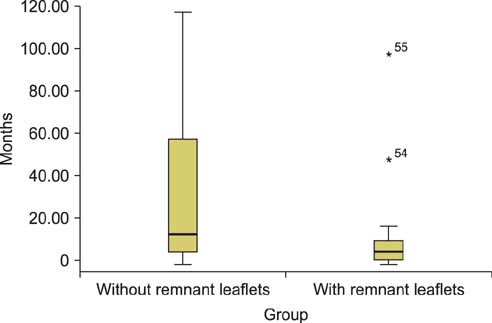Korean J Urol.
2014 Jan;55(1):64-68. 10.4111/kju.2014.55.1.64.
Which Patients Are at Higher Risk for Residual Valves After Posterior Urethral Valve Ablation?
- Affiliations
-
- 1Department of Urology, Shiraz University of Medical Sciences, Shiraz, Iran. mohamadreza_far30@yahoo.com
- KMID: 1988455
- DOI: http://doi.org/10.4111/kju.2014.55.1.64
Abstract
- PURPOSE
To find patients at high risk of obstructive remnant leaflets after valve ablation among boys with posterior urethral valve (PUV), we evaluated any possible relationship between preoperative findings in our patients and residual obstructive leaflets after valve ablation.
MATERIALS AND METHODS
We retrospectively reviewed the medical records of 55 patients with PUV that was treated by the same surgeon between 2008 and 2012. Of these, 37 patients (67.3%) had no obstructive remnant leaflets (group A) and 18 patients (32.7%) had obstructive remnant leaflets (group B) in follow-up cystoscopy. Preoperative clinical and radiological findings were evaluated and compared between the groups.
RESULTS
Among all the preoperative data we examined, the analysis revealed that age at the time of surgery (median age: group A, 15 months; group B, 7 months; p=0.017), echogenicity of kidneys (p<0.05), presence of vesicoureteral reflux (p<0.05), and grade of reflux (p<0.05) were significantly different between the groups. Method of valve ablation, anterior-posterior diameters of the renal pelvis, renal cortical thickness, bladder wall thickening, and scarring on the dimercaptosuccinic acid scan showed no significant differences between the two groups.
CONCLUSIONS
In our patients, younger age at surgery time, hyperechogenicity of renal parenchyma, presence of vesicoureteral reflux, and grade 4 or 5 reflux before surgery had a significant relationship with residual valves. More studies may result in enhanced management of patients at high risk of residual valves after PUV ablation, because the sooner the obstruction is resolved entirely, the better the outcome.
MeSH Terms
Figure
Reference
-
1. Smeulders N, Makin E, Desai D, Duffy PG, Healy C, Cuckow PM, et al. The predictive value of a repeat micturating cystourethrogram for remnant leaflets after primary endoscopic ablation of posterior urethral valves. J Pediatr Urol. 2011; 7:203–208.2. Hutton KA. Management of posterior urethral valves. Curr Paediatr. 2004; 14:568–575.3. Bani Hani O, Prelog K, Smith GH. A method to assess posterior urethral valve ablation. J Urol. 2006; 176:303–305.4. Gunn TR, Mora JD, Pease P. Antenatal diagnosis of urinary tract abnormalities by ultrasonography after 28 weeks' gestation: incidence and outcome. Am J Obstet Gynecol. 1995; 172(2 Pt 1):479–486.5. Caione P, Nappo SG. Posterior urethral valves: long-term outcome. Pediatr Surg Int. 2011; 27:1027–1035.6. Deshpande AV, Alsaywid BS, Smith GH. Setting the speed limit: a pilot study of the rate of serum creatinine decrease after endoscopic valve ablation in neonates. J Urol. 2011; 185:6 Suppl. 2497–2500.7. Oktar T, Salabas E, Acar O, Atar A, Nane I, Ander H, et al. Residual valve and stricture after posterior urethral valve ablation: how to evaluate? J Pediatr Urol. 2013; 9:184–187.8. Sarhan OM, El-Ghoneimi AA, Helmy TE, Dawaba MS, Ghali AM, Ibrahiem el-HI. Posterior urethral valves: multivariate analysis of factors affecting the final renal outcome. J Urol. 2011; 185:6 Suppl. 2491–2495.9. Burmeister D, AbouShwareb T, DAgostino R Jr, Andersson KE, Christ GJ. Impact of partial urethral obstruction on bladder function: time-dependent changes and functional correlates of altered expression of Ca2+ signaling regulators. Am J Physiol Renal Physiol. 2012; 302:F1517–F1528.10. Mirone V, Imbimbo C, Longo N, Fusco F. The detrusor muscle: an innocent victim of bladder outlet obstruction. Eur Urol. 2007; 51:57–66.11. Levin RM, Chichester P, Hass MA, Gosling JA, Buttyan R. Obstructive bladder dysfunction: morphological, biochemical and molecular changes. Eur Urol Suppl. 2002; 1:14–20.12. Oliveira EA, Rabelo EA, Pereira AK, Diniz JS, Cabral AC, Leite HV, et al. Prognostic factors in prenatally-detected posterior urethral valves: a multivariate analysis. Pediatr Surg Int. 2002; 18:662–667.13. Lopez Pereira P, Espinosa L, Martinez Urrutina MJ, Lobato R, Navarro M, Jaureguizar E. Posterior urethral valves: prognostic factors. BJU Int. 2003; 91:687–690.14. Akdogan B, Dogan HS, Keskin S, Burgu B, Tekgul S. Significance of age-specific creatinine levels at presentation in posterior urethral valve patients. J Pediatr Urol. 2006; 2:446–452.15. Sarhan O, El-Ghoneimi A, Hafez A, Dawaba M, Ghali A, Ibrahiem el-H. Surgical complications of posterior urethral valve ablation: 20 years experience. J Pediatr Surg. 2010; 45:2222–2226.16. Duckett JW, Bellinger MF. A plea for standardized grading of vesicoureteral reflux. Eur Urol. 1982; 8:74–77.17. Nasir AA, Ameh EA, Abdur-Rahman LO, Adeniran JO, Abraham MK. Posterior urethral valve. World J Pediatr. 2011; 7:205–216.18. Smith GH, Canning DA, Schulman SL, Snyder HM 3rd, Duckett JW. The long-term outcome of posterior urethral valves treated with primary valve ablation and observation. J Urol. 1996; 155:1730–1734.19. Gupta RK, Shah HS, Jadhav V, Gupta A, Prakash A, Sanghvi B, et al. Urethral ratio on voiding cystourethrogram: a comparative method to assess success of posterior urethral valve ablation. J Pediatr Urol. 2010; 6:32–36.20. Zerin JM. Morphologic studies of the urinary tract. Gearhart JG, Rink RC, Mouriquand PD. Pediatric urology. 2nd ed. Philadelphia: Elsevier Saunders;2010. p. 67.21. El-Sherbiny MT, Hafez AT, Shokeir AA. Posterior urethral valves: does young age at diagnosis correlate with poor renal function? Urology. 2002; 60:335–338.22. Wiersma F, Toorenvliet BR, Ruige M, Holscher HC. Increased echogenicity of renal cortex: a transient feature in acutely ill children. AJR Am J Roentgenol. 2008; 190:240–243.


